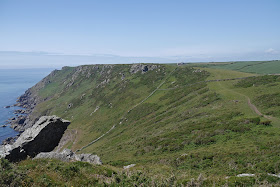Salcombe Harbour
We started from the ferry pier in Salcombe and walked up the hill out of the town, amazed by how many shops there were selling men's casual clothing - if only there was time to investigate properly! After passing the beaches at North Sands and South Sands, a steep wooded path leads up to the National Trust property, Overbeck's, famous for its gardens and eccentric collections more than for its architectural merit. There were many fine views back towards Salcombe harbour.
You continue in woods after the house and we were very taken by these tiny flowers, about the size of a Herb Robert. As so often, I have failed to identify them.
We emerged into more open country and soon found ourselves looking down on the greeny-blue water of Starehole Bay, with Bolt Head on the far side.
My eye was caught by an emerald-green insect and when it landed on some ivy, I realised there was a Green Hairstreak nearby. I was delighted - a new sighting for me.
This was the view back over the bay from Bolt Head, with Limeberry Head behind.
We paused at a bench which offered great views in all directions and I quickly became aware of a number of quite large, fast-flying orange butterflies. I leaped up and pursued them downhill over the bracken. It was a bit like the poor traveller being lured off his path by a will o' the wisp in a fairy story. By the time I was getting close to the cliff edge at the bottom of the slope I was no nearer to getting a photo or a clear sight of the all-important under-wing markings which enable one Fritillary to be told from another. Subsequent research strongly suggests they were Pearl-bordered Fritillaries: the continuous flight a metre or so above the ground (searching for newly emerged females) is characteristic, bracken covered scrubby hillsides are a known habitat and South Devon one of the few areas where they are found. Exciting, but frustrating that I couldn't get a picture or even a clear visual impression.
We climbed up to a rocky saddle and then descended to enter the large plateau known as The Warren. There were further intermittent Fritillary sightings as we went along.
Ahead of us for much of the way was this lovely square tower and I made a slight detour inland to take a picture. I have found a couple of other photos of it by Googling, but no information about what it is or was.
After Steeple Point ...
... there is a sharp change and the path descends steeply revealing a dramatic coastline ahead.
After the descent, you climb again - it is the coast path after all - and a pretty, small cove offers a view of the Ham Stone out to sea.
Then, after some tantalising glimpses, the fantastic sight of Soar Mill Cove unfolds in its full glory below.
A steep descent brings you down to sea level where the pair of rocks known for some reason as the Parson and the Clerk dominate the view. Perhaps unconvincingly, this put me in mind of our first sight of Hahei beach on the Pacific coast of New Zealand's North Island.
After a steep climb up the other side, we now followed a ridge-top path, with a green valley on the landward side.
Now we crossed Bolberry Down, at the end of which there was a dramatic view between two rocks back along the coast.
Soon after this we reached the grassy promontory known as Bolt Tail, overlooking Hope Cove and with Burgh Island, which dominates the next section of coast, beyond.
Just as we were going through a gate, I spotted another Fritillary, smaller and less brightly orange than the ones we had seen earlier in the walk. This one too wouldn't reveal its under-wings, but I have subsequently identified it as a Small Pearl-Bordered Fritillary - another new sighting!
We followed the grassy trail to come down into Inner Hope, where there is an unexpected but delightful group of thatched cottages.
We had parked in Outer Hope, so we completed our walk by crossing the beach - it was low water - and marvelling at the pale pink stones which were scattered across it.
Conditions: sunny and warm.
Distance: 8 miles. Distance now covered 185.1 miles.
Map: OL 20 South Devon.
Rating: Five stars. An excellent day for butterflies (we saw another ten species, including a Wall, beyond those mentioned). The scenery around Soar Mill Cove is some of the best we have yet seen.



















The square tower is a lookout dating possibly to 18C. See https://historicengland.org.uk/listing/the-list/list-entry/1306784
ReplyDelete